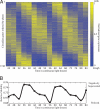Oscillations in supercoiling drive circadian gene expression in cyanobacteria
- PMID: 20018699
- PMCID: PMC2799730
- DOI: 10.1073/pnas.0912673106
Oscillations in supercoiling drive circadian gene expression in cyanobacteria
Abstract
The cyanobacterium Synechococcus elongatus PCC 7942 exhibits oscillations in mRNA transcript abundance with 24-h periodicity under continuous light conditions. The mechanism underlying these oscillations remains elusive--neither cis nor trans-factors controlling circadian gene expression phase have been identified. Here, we show that the topological status of the chromosome is highly correlated with circadian gene expression state. We also demonstrate that DNA sequence characteristics of genes that appear monotonically activated and monotonically repressed by chromosomal relaxation during the circadian cycle are similar to those of supercoiling-responsive genes in Escherichia coli. Furthermore, perturbation of superhelical status within the physiological range elicits global changes in gene expression similar to those that occur during the normal circadian cycle.
Conflict of interest statement
The authors declare no conflict of interest.
Figures




Similar articles
-
Spatiotemporal Coupling of DNA Supercoiling and Genomic Sequence Organization-A Timing Chain for the Bacterial Growth Cycle?Biomolecules. 2022 Jun 15;12(6):831. doi: 10.3390/biom12060831. Biomolecules. 2022. PMID: 35740956 Free PMC article. Review.
-
Circadian rhythms of superhelical status of DNA in cyanobacteria.Proc Natl Acad Sci U S A. 2007 Nov 20;104(47):18819-24. doi: 10.1073/pnas.0706069104. Epub 2007 Nov 13. Proc Natl Acad Sci U S A. 2007. PMID: 18000054 Free PMC article.
-
Circadian rhythms in gene transcription imparted by chromosome compaction in the cyanobacterium Synechococcus elongatus.Proc Natl Acad Sci U S A. 2006 May 30;103(22):8564-9. doi: 10.1073/pnas.0508696103. Epub 2006 May 17. Proc Natl Acad Sci U S A. 2006. PMID: 16707582 Free PMC article.
-
An RpaA-Dependent Sigma Factor Cascade Sets the Timing of Circadian Transcriptional Rhythms in Synechococcus elongatus.Cell Rep. 2018 Dec 11;25(11):2937-2945.e3. doi: 10.1016/j.celrep.2018.11.049. Cell Rep. 2018. PMID: 30540929
-
A circadian timing mechanism in the cyanobacteria.Adv Microb Physiol. 2007;52:229-96. doi: 10.1016/S0065-2911(06)52004-1. Adv Microb Physiol. 2007. PMID: 17027373 Review.
Cited by
-
The circadian clock ensures successful DNA replication in cyanobacteria.Proc Natl Acad Sci U S A. 2021 May 18;118(20):e2022516118. doi: 10.1073/pnas.2022516118. Proc Natl Acad Sci U S A. 2021. PMID: 33972427 Free PMC article.
-
Nuclear envelope regulates the circadian clock.Nucleus. 2015;6(2):114-7. doi: 10.1080/19491034.2015.1010949. Epub 2015 Mar 6. Nucleus. 2015. PMID: 25746393 Free PMC article.
-
Coupling of Cellular Processes and Their Coordinated Oscillations under Continuous Light in Cyanothece sp. ATCC 51142, a Diazotrophic Unicellular Cyanobacterium.PLoS One. 2015 May 14;10(5):e0125148. doi: 10.1371/journal.pone.0125148. eCollection 2015. PLoS One. 2015. PMID: 25973856 Free PMC article.
-
Spatiotemporal Coupling of DNA Supercoiling and Genomic Sequence Organization-A Timing Chain for the Bacterial Growth Cycle?Biomolecules. 2022 Jun 15;12(6):831. doi: 10.3390/biom12060831. Biomolecules. 2022. PMID: 35740956 Free PMC article. Review.
-
Hypersensitive photic responses and intact genome-wide transcriptional control without the KaiC phosphorylation cycle in the Synechococcus circadian system.J Bacteriol. 2014 Feb;196(3):548-55. doi: 10.1128/JB.00892-13. Epub 2013 Nov 15. J Bacteriol. 2014. PMID: 24244001 Free PMC article.
References
-
- Dunlap JC, Loros JJ, DeCoursey PJ. Chronobiology—Biological Timekeeping. Sunderland, MA: Sinauer Associates; 2004.
-
- Liu Y, et al. Circadian orchestration of gene expression in cyanobacteria. Genes Dev. 1995;9:1469–1478. - PubMed
-
- Nakajima M, et al. Reconstitution of circadian oscillation of cyanobacterial KaiC phosphorylation in vitro. Science. 2005;308:414–415. - PubMed
Publication types
MeSH terms
Substances
Associated data
- Actions
Grants and funding
LinkOut - more resources
Full Text Sources
Other Literature Sources
Molecular Biology Databases

